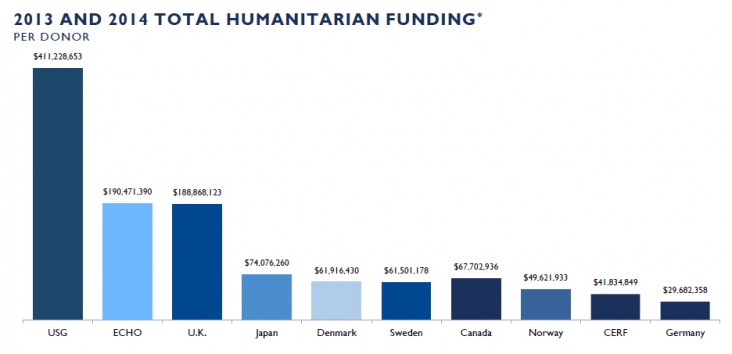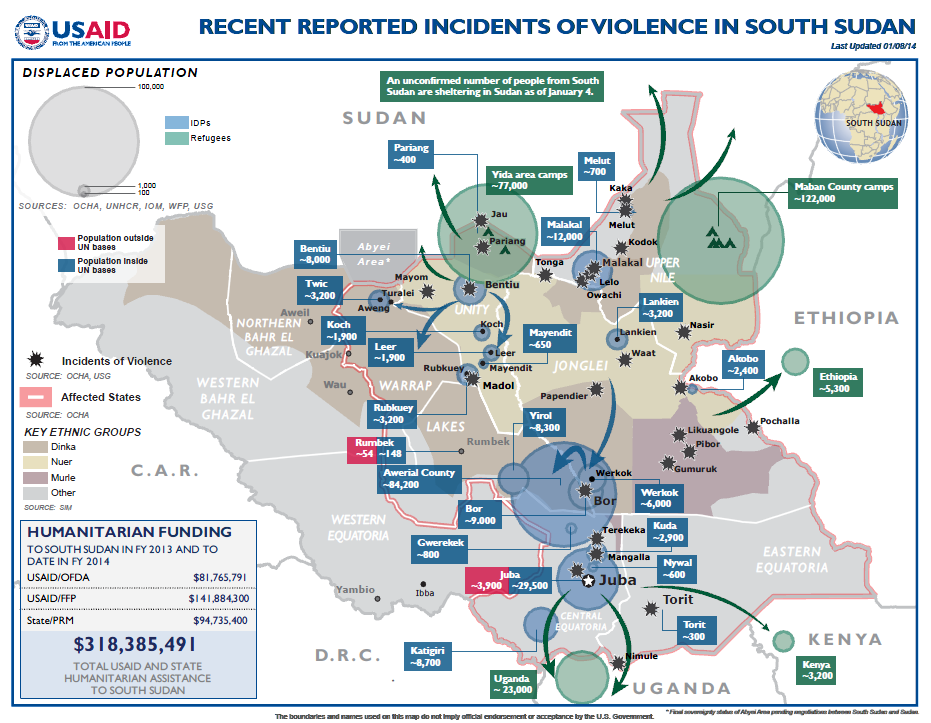- What We Do
- Agriculture and Food Security
- Democracy, Human Rights and Governance
- Economic Growth and Trade
- Education
- Environment and Global Climate Change
- Gender Equality and Women's Empowerment
- Global Health
- Humanitarian Assistance
- Transformation at USAID
- Water and Sanitation
- Working in Crises and Conflict
- U.S. Global Development Lab
Speeches Shim
January 14, 2013
Numbers At A Glance
413,000
66,500
346,500
74,300
229,587
Humanitarian Funding:
To South Sudan To Date In FY2013 and FY2014:
| USAID/OFDA | $81,765,791 |
| USAID/FFP | $141,884,300 |
| State/PRMDoD | $94,735,400 |
| TOTAL | $318,385,491 |
Highlights
Hostilities in Upper Nile State result in additional population displacement.
Relief agencies distribute 30-day food rations to internally displaced persons (IDPs) in Bor town.
Insecurity continues to impede humanitarian assistance in Bentiu, Unity State.
KEY DEVELOPMENTS
As of January 13, violence since December 15 had displaced approximately 413,000 people in South Sudan, with 66,500 people currently seeking shelter at UNMISS bases across the country, according to the U.N. Although an estimated 203,000 people have received some humanitarian assistance, the U.N. notes that relief agencies have not fully met needs among assisted populations due to a lack of sustained, predictable access.
The number of people seeking shelter at the UNMISS base in Malakal town, Upper Nile State, increased from approximately 12,000 people to an estimated 18,000 people in recent days, the U.N. reports. Many civilians pre-emptively fled to the UNMISS base, fearing an imminent attack on the town by opposition forces. On January 12, a boat transporting civilians fleeing Malakal sank, resulting in the death of at least 200 people, according to international media.
The U.N. estimates that 74,300 people have fled to neighboring countries as a result of recent violence, including 38,700 to Uganda, 18,600 to Ethiopia, and 7,000 to Kenya. Total refugee figures include an unconfirmed number of people from South Sudan who have arrived in Sudan’s Western Kordofan and Southern Kordofan states, according to the U.N.
SITUATION AND DISPLACEMENT UPDATE
Ongoing hostilities in many areas of South Sudan continue to impede the delivery of critical humanitarian assistance to vulnerable populations. Despite constraints, humanitarian agencies are providing support as access and security allow, reaching approximately 203,000 people with limited humanitarian assistance as of January 13.
While the security situation in Juba—the planning and operational base for most relief agencies—remained calm but tense, the U.N. reports that clashes between Government of the Republic of South Sudan (RSS) troops and opposition forces occurred near Mangalla town, Central Equatoria State, approximately 30 miles northeast of Juba on January 13.
Humanitarian access to Bor town, Jonglei State, remains severely restricted, as humanitarian organizations remain unable to secure safety assurances needed to commence flights into the town. The U.N. has received reports of large numbers of IDPs in Fangak and Lankien towns in northern Jonglei.
Following heavy fighting in Mayom and Rubkona counties, Unity State, the U.N. has received reports of widespread destruction of civilian property.
South Sudan Crisis Fact Sheet #16 January 14, 2014 ![]() (pdf - 401k)
(pdf - 401k)
HUMANITARIAN RESPONSE IN JUBA, CENTRAL EQUATORIA STATE
Overcrowding at the two Juba UNMISS sites—Tong Ping and U.N. House 3—remains a concern. To relieve the severely overcrowded Tong Ping site, humanitarian organizations have established a site extension at the slightly less crowded U.N. House 3 to accommodate new arrivals. As of January 13, approximately 100 new arrivals had transferred to U.N. House 3, and relief agencies had registered the new arrivals there, according to the U.N. Relief agencies are working to identify and prepare an additional IDP site where UNMISS will provide physical protection of civilians.
Humanitarian agencies have established an infant and young child feeding program to help prevent child and infant malnutrition in Juba, with plans to extend the program to all IDP sites across South Sudan in the coming months.
Protection of civilians is a critical need at all IDP sites in South Sudan. In Juba, the Protection Cluster—the coordinating body for humanitarian protection activities, comprising U.N. agencies, non-governmental organizations (NGOs), and other stakeholders—continues to strengthen protection activities at the two UNMISS bases in Juba through family tracing and unification programs as well as counselling and medical care for survivors of gender-based violence.
IDPs sheltering at Tong Ping and U.N. House 3 have access to over 20 liters of water per day, surpassing minimum Sphere[1] standards, according to the U.N. While relief agencies have constructed nearly 550 latrines at the two UNMISS compounds, the latrine-to-people ratio falls below Sphere standards due to a lack of space to build additional latrines at both sites.
South Sudan Crisis Map #16 January 14, 2014 ![]() (pdf - 435k)
(pdf - 435k)
HUMANITARIAN NEEDS AND RESPONSE IN OTHER AREAS OF SOUTH SUDAN
Despite the volatile security situation and restriction on humanitarian flights to Bor, humanitarian organizations are providing life-saving assistance to IDPs sheltering at the UNMISS base in Bor, as security conditions allow. On January 12, a water, sanitation, and hygiene (WASH) team distributed emergency supplies and sought to improve sanitation services and expand access to safe-drinking water for IDPs. In addition, USAID/FFP partner the UN World Food Program (WFP), in coordination with OCHA and UNMISS staff, successfully accessed pre-positioned food stocks from a local warehouse and began distributing 30-day food rations to civilians at the UNMISS base as of January 13. Previously, limited access to food supplies prevented relief agencies from distributing more than two-day rations.
Most civilians have reportedly left their homes in Malakal to seek refuge at the Malakal UNMISS base, where an estimated 18,000 people are sheltering, according to the U.N. To date, relief agencies have registered approximately 8,000 people to improve displacement tracking and assess humanitarian need. Although people at the compound are only accessing 8 liters of water per person per day—below international standards—due to new population influxes, latrine construction and soap distribution are underway to improve WASH conditions among IDPs. Humanitarian organizations have pre-positioned relief items for 3,000 families at the Malakal base for distribution in the coming days, according to the U.N.
In Awerial County, Lakes State, population movements and the number of people displaced—currently estimated at 84,000 people—remain fluid, as relief agencies register IDPs upon arrival in the county but remain unable to track departing populations, the U.N. reports. The U.N. notes that blankets and food support remain priority humanitarian needs for IDPs in Awerial. While current safe drinking water distribution in Awerial—estimated at 10 liters of water per person per day—is below international standards, relief agencies are installing a third water treatment system to increase the water supply and are constructing 650 latrines to improve sanitation conditions. The WASH Cluster continues to increase staffing and is deploying an experienced sub-cluster coordinator, who will be based in Awerial, in the coming days.
The unstable security situation in Bentiu continues to hamper humanitarian assistance. Emergency surgical care remains a priority humanitarian need in Unity State, with Bentiu Hospital—the main hospital in Unity State—not operational. Despite volatile security conditions, relief agencies are distributing food rations to civilians at the Bentiu UNMISS base and had reached 1,800 new arrivals as of January 12. Relief agencies are also constructing 400 latrines to improve WASH conditions.
Since December 15, medical facilities have treated more than 2,600 patients with gunshot wounds, including 190 who were evacuated for medical treatment.
OTHER HUMANITARIAN ASSISTANCE
Since launching the South Sudan Crisis Response Plan on December 31, relief organizations have secured approximately $104 million of the $209 million in requested funding to meet immediate needs in South Sudan from January to March, including a $50 million contribution from the U.S. Government. On January 14, the Government of Japan announced plans to provide an additional $25 million, including $20 million to the South Sudan Crisis Response Plan, to support humanitarian operations in South Sudan. To ensure that humanitarian organizations operating in field locations receive sufficient funding to implement programs, international donors continue to consult with the cluster system.
The USAID/OFDA-funded Rapid Response Fund (RRF), managed by the International Organization of Migration, is quickly routing funding to international and national NGOs working on the ground in South Sudan to provide assistance to IDPs in UNMISS camps, as well as those displaced to rural areas. Since fighting began on December 15, USAID/OFDA has awarded more than $2 million through the RRF, with partners focusing on critical health, protection, relief item, and WASH needs among IDPs. On January 14, the Danish Refugee Council received more than $340,000 in RRF funding to provide humanitarian aid—including camp coordination and management services, emergency relief supplies, protection assistance, and shelter—to displaced populations located at UNMISS bases in Bentiu and Malakal.

2013 TOTAL HUMANITARIAN FUNDING*
*Funding figures are as of January 14, 2014. All international figures are according to OCHA’s Financial Tracking Service (FTS) and based on international commitments during the 2013 and 2014 calendar years, while USG figures are according to the USG and reflect the most recent USG commitments based on the 2013 fiscal year, which began on October 1, 2012, and ended September 30, 2013, as well as the 2014 fiscal year, which began on October 1, 2013.



Comment
Make a general inquiry or suggest an improvement.